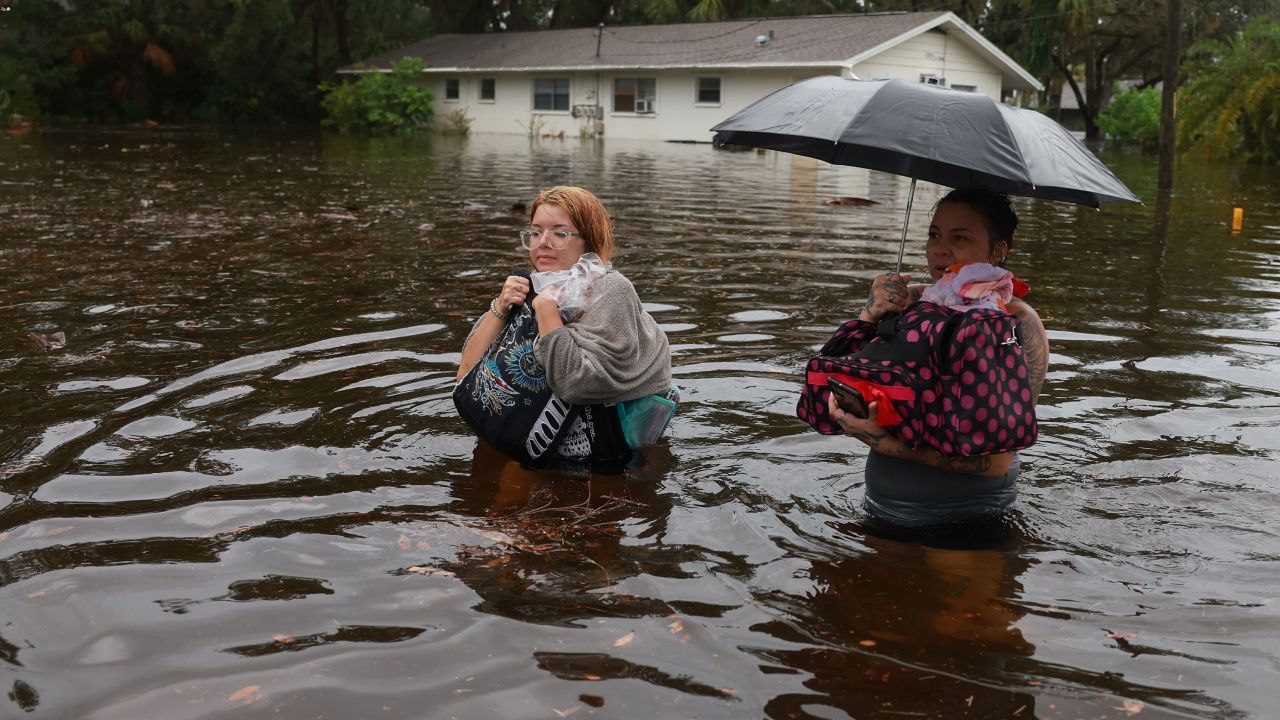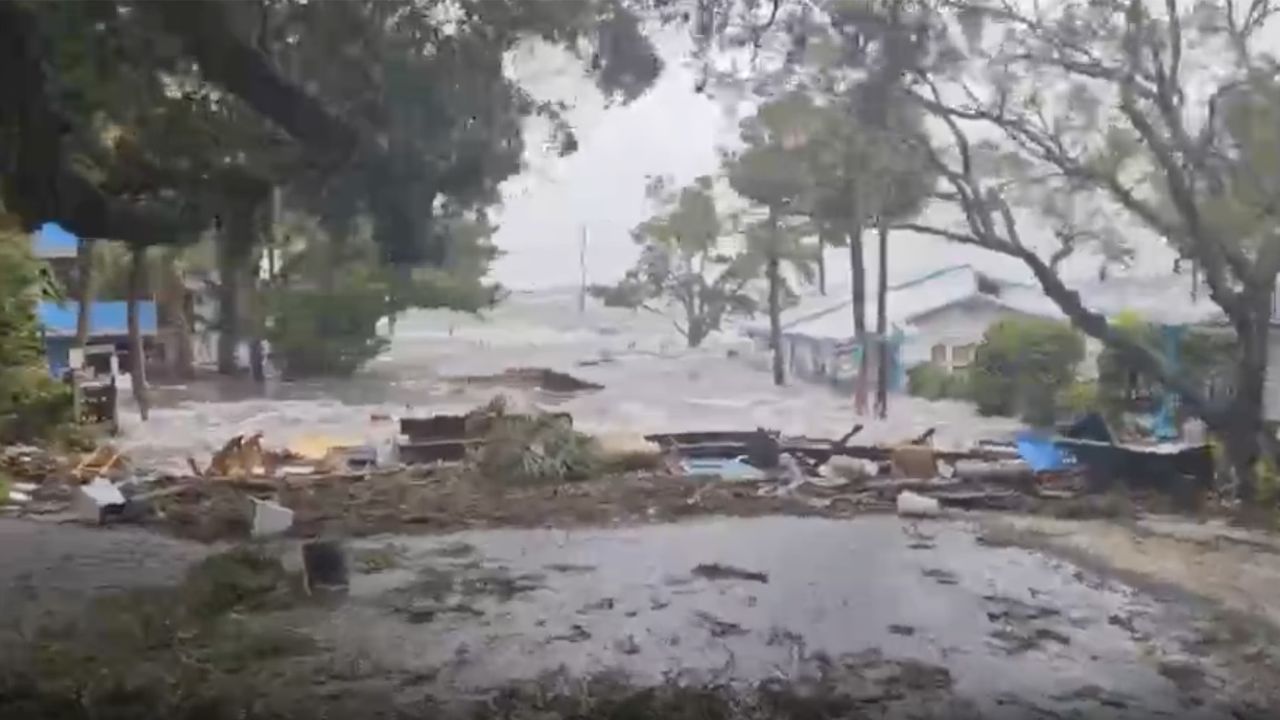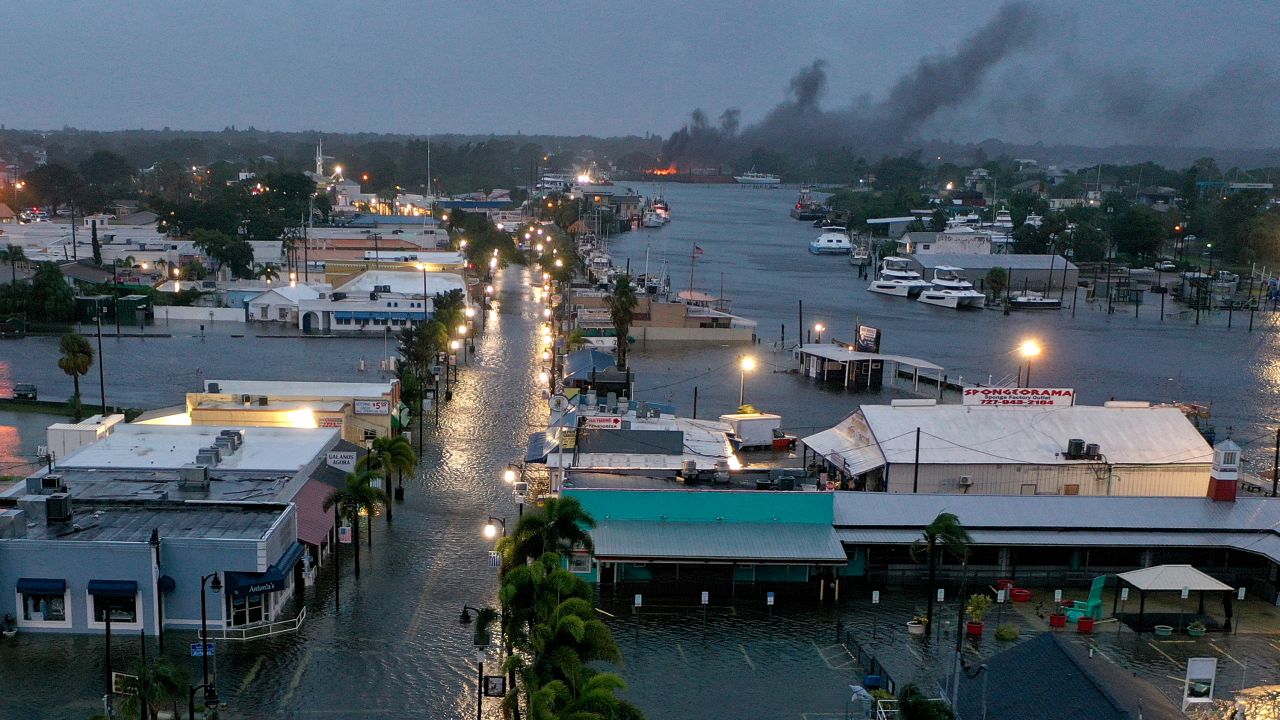Editor’s note: Hit by a storm? Use CNN Lite site For low frequency.
CNN
—
After hitting parts of Florida on Wednesday evening, Italia weakened to a tropical storm as it trekked across the Southeast, threatening parts of Georgia and the Carolinas with strong winds and flooding.
In Florida’s Crystal River, water levels appeared to be receding, but high tides are still expected and existing flooding remains dangerous, City Councilman Ken Frink told CNN Wednesday afternoon.
“Right now, it’s still a catastrophic event,” Frink said. “All the houses around us are under water.”
In nearby coastal Pasco County, north of Tampa, about 6,000 homes were “inundated,” an official said.
“A lot of what we’re seeing is major damage. I mean, we’ve got at least 18 inches or more of water going into these homes,” Pasco County Emergency Management Assistant Director Laura Wilcoxon told CNN.
The storm had sustained winds of 70 mph and was about 40 miles west of Savannah, Georgia, as of 5 p.m. Advice From the National Hurricane Center.
Risks of storm surge, freshwater flooding and strong winds remain for parts of Georgia and the Carolinas, the center said.
In Georgia, Governor Brian Kemp said Several districts in the southern part of the state are witnessing powerful winds on Wednesday, and heavy rain is expected.
In storm-ravaged Florida, officials warn that the danger is far from over, even though the skies are clearing.
“We still have a lot of water coming into the Tampa Bay area, make sure you’re not driving through standing water,” Wilcoxon said.
In Citrus County, which includes Crystal River, Sheriff Mike Prendergast told CNN the effects of the hurricane will “play out for a long time.”
“Where I’m standing right now, by Wednesday afternoon, before high tide comes in, we’ll probably be under 6 feet of water,” he said.
“We fear that residents will walk outside, see that it’s sunny outside and think everything is fine. But there’s still water coming in,” warned Rob Herrin, a spokesman for Hillsborough County Fire Rescue.

Prendergast urged people not to wade into the water filled streets.
“Don’t go in that water because it’s salt water mixed with a lot of other stuff,” the sheriff said.
“It’s going to destroy your vehicles, and then it’s going to leave you with an expensive repair bill every time you ride through the storm.”
Track Idalia here >>
Italia hit Florida’s Big Bend region – the corner between the Panhandle and the peninsula – near Keaton Beach on Wednesday morning as a dangerous Category 3 storm. That stretch of the Gulf Coast hasn’t seen such deadly storm surge and winds in at least 125 years.
“Conditions will begin to gradually improve in Florida later today, but water levels will be elevated – particularly along the Big Bend coast to Tampa throughout the day today,” National Hurricane Center Director Michael Brennan said Wednesday.
Follow live updates from Hurricane Italia
At least two men were killed in separate weather-related car crashes Wednesday, Florida Highway Patrol Sgt. Steve Gaskins said. Their deaths mark the first deaths linked to Hurricane Idalia.
In the vulnerable island town of Cedar Key, water levels broke records amid a storm surge of 8 to 9 feet. And the water was rising even faster — seawater is predicted to wash up to halfway up the second floor of an average building.
Tampa, St. Petersburg and Fort Myers Beach were also hit by wind-blown seawater and torrential rain.

The island town of Cedar Key looked “almost apocalyptic” before the landslide, resident Michael Babbitt said Wednesday morning. A few hours later, a devastating storm surge engulfed it.

“We are now effectively cut off from the world,” Babbitt said. “It’s going to get worse, and I’m very afraid of what we’re going to find in some of the low-lying areas and our elderly, frail citizens today.”
Storm surge accounts for half of all hurricane-related deaths, according to the National Oceanic and Atmospheric Administration.
Here are other developments from across the region:
• Air traffic was suspended: Hundreds of flights were canceled as Tampa International Airport suspended commercial operations and the terminal building at St. Pete-Clearwater International Airport was closed Tuesday..
“The Tampa airport is going to reopen to inbound flights at 4 p.m.,” DeSantis said Wednesday. “At 3am tomorrow, it will be fully reopened.” Gainesville and Tallahassee airports are also slated to reopen Thursday morning, the governor said.
In Georgia, Savannah/Hilton Head International Airport announced Wednesday that flights out of the airport would be canceled for the rest of the day.
• Bridges are closed: Major bridges connecting St. Petersburg to mainland Florida are closed, according to online data from the Florida Department of Transportation. Road access to the small barrier islands is also closed, Pinellas County Emergency Management X said earlier on Twitter.
• Power out: About 262,000 homes, businesses and other electric customers were without power in Florida and about 208,000 in Georgia as of 4 p.m. Wednesday. PowerOutage.com.
• Evacuation in at least 28 districts: Alachua, Baker, Citrus, Dixie, Franklin, Gilchrist, Gulf, Hamilton, Hernando, Hillsborough, Jefferson, Lafayette, Leon, Levy, Madison, Manatee, Marion, Nassau, Pasco, Pinellas, Putnam, Sarasota, Suwanee, Union, Volusia and Wakulla have all issued evacuation orders, some mandatory. The emergency declaration covers 49 of Florida’s 67 counties.
• Thousands are in shelters: About 4,500 people have taken shelter in shelters in the affected area, according to Red Cross data on Wednesday. Most of the people — 442 — were at one site in Largo, Florida, with more than 100 shelters open in the storm’s path, the aid group said.

• Hospitals suspend services: Patients were transferred from three hospitals: HCA Florida Pasadena Hospital, HCA Florida Trinity West Hospital, and HCA Florida West Tampa Hospital. Meanwhile, Tampa General Hospital was building a watertight barrier to stay open for emergency care.
• Schools and universities are closed: All 50 county school districts have issued closures, as have dozens of college and university systems across Florida.
• Thousands of prisoners were evacuated: About 4,000 inmates were evacuated or moved to facilities better equipped to handle the storm, according to the Florida Department of Corrections.
The National Hurricane Center said Italia’s center will move near or along the coasts of Georgia, South Carolina and North Carolina late Wednesday and Thursday.
“Italia may still become a hurricane as it moves across southern Georgia, and as it approaches the coast of Georgia or South Carolina late today,” the storm center said Wednesday morning.
A state of emergency has been declared in North Carolina and Georgia as they brace for flooding and tornadoes.
In Georgia, Savannah could see tropical storm conditions through Wednesday night, with flooding and storm surge of 3 to 5 feet and possible tornadoes. The storm’s outer bands could bring thunderstorms and gusts up to 20 mph over Atlanta.
Charleston, South Carolina, could see tropical storm conditions early Thursday, including heavy rain, flooding, tornadoes and a storm surge of 3 to 5 feet.
In Wilmington, North Carolina, tropical storm conditions are possible through Thursday, with heavy rain, flooding and storm surge of 1 to 3 feet.